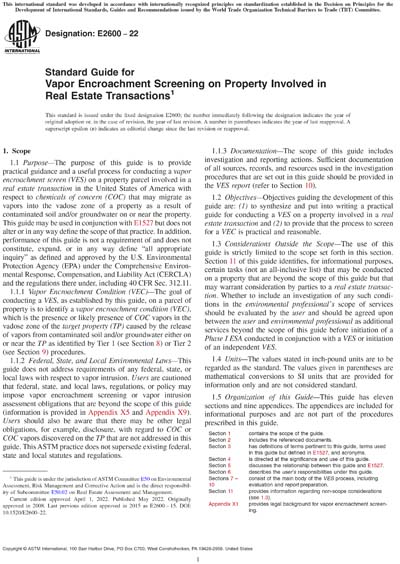Most recent
ASTM E2600-22
Standard Guide for Vapor Encroachment Screening on Property Involved in Real Estate Transactions
1.1Purpose - The purpose of this guide is to provide practical guidance and a useful process for conducting a vapor encroachment screen (VES) on a property parcel involved in a real estate transaction in the United States of America with respect to chemicals of concern (COC) that may migrate as vapors into the vadose zone of a property as a result of contaminated soil and/or groundwater on or near the property. This guide may be used in conjunction with E1527 but does not alter or in any way define the scope of that practice. In addition, performance of this guide is not a requirement of and does not constitute, expand, or in any way define "all appropriate inquiry" as defined and approved by the U.S. Environmental Protection Agency (EPA) under the Comprehensive Environmental Response, Compensation, and Liability Act (CERCLA) and the regulations there under, including 40 CFR Sec. 312.11.
1.1.1Vapor Encroachment Condition (VEC) - The goal of conducting a VES, as established by this guide, on a parcel of property is to identify a vapor encroachment condition (VEC), which is the presence or likely presence of COC vapors in the vadose zone of the target property (TP) caused by the release of vapors from contaminated soil and/or groundwater either on or near the TP as identified by Tier 1 (see Section 8) or Tier 2 (see Section 9) procedures.
1.1.2Federal, State, and Local Environmental Laws - This guide does not address requirements of any federal, state, or local laws with respect to vapor intrusion. Users are cautioned that federal, state, and local laws, regulations, or policy may impose vapor encroachment screening or vapor intrusion assessment obligations that are beyond the scope of this guide (information is provided in Appendix X5 and Appendix X9). Users should also be aware that there may be other legal obligations, for example, disclosure, with regard to COC or COC vapors discovered on the TP that are not addressed in this guide. This ASTM practice does not supersede existing federal, state and local statutes and regulations.
1.1.3Documentation - The scope of this guide includes investigation and reporting actions. Sufficient documentation of all sources, records, and resources used in the investigation procedures that are set out in this guide should be provided in the VES report (refer to Section 10).
1.2Objectives - Objectives guiding the development of this guide are: (1) to synthesize and put into writing a practical guide for conducting a VES on a property involved in a real estate transaction and (2) to provide that the process to screen for a VEC is practical and reasonable.
1.3Considerations Outside the Scope - The use of this guide is strictly limited to the scope set forth in this section. Section 11 of this guide identifies, for informational purposes, certain tasks (not an all-inclusive list) that may be conducted on a property that are beyond the scope of this guide but that may warrant consideration by parties to a real estate transaction. Whether to include an investigation of any such conditions in the environmental professional's scope of services should be evaluated by the user and should be agreed upon between the user and environmental professional as additional services beyond the scope of this guide before initiation of a Phase I ESA conducted in conjunction with a VES or initiation of an independent VES.
1.4Units - The values stated in inch-pound units are to be regarded as the standard. The values given in parentheses are mathematical conversions to SI units that are provided for information only and are not considered standard.
1.5Organization of this Guide - This guide has eleven sections and nine appendices. The appendices are included for informational purposes and are not part of the procedures prescribed in this guide.
1.6This guide does not purport to address all of the safety concerns, if any, associated with its use. It is the responsibility of the user of this standard to establish appropriate safety, health, and environmental practices and determine the applicability of regulatory limitations prior to use.
1.7This guide cannot replace education or experience and should be used in conjunction with professional judgment. Not all aspects of this guide may be applicable in all circumstances. This ASTM standard is not intended to represent or replace the standard of care by which the adequacy of a given professional service must be judged, nor should this guide be applied without consideration of a project's many unique aspects. The word "Standard" in the title means only that the guide has been approved through the ASTM consensus process.
1.8This international standard was developed in accordance with internationally recognized principles on standardization established in the Decision on Principles for the Development of International Standards, Guides and Recommendations issued by the World Trade Organization Technical Barriers to Trade (TBT) Committee.
ASTM International [astm]

